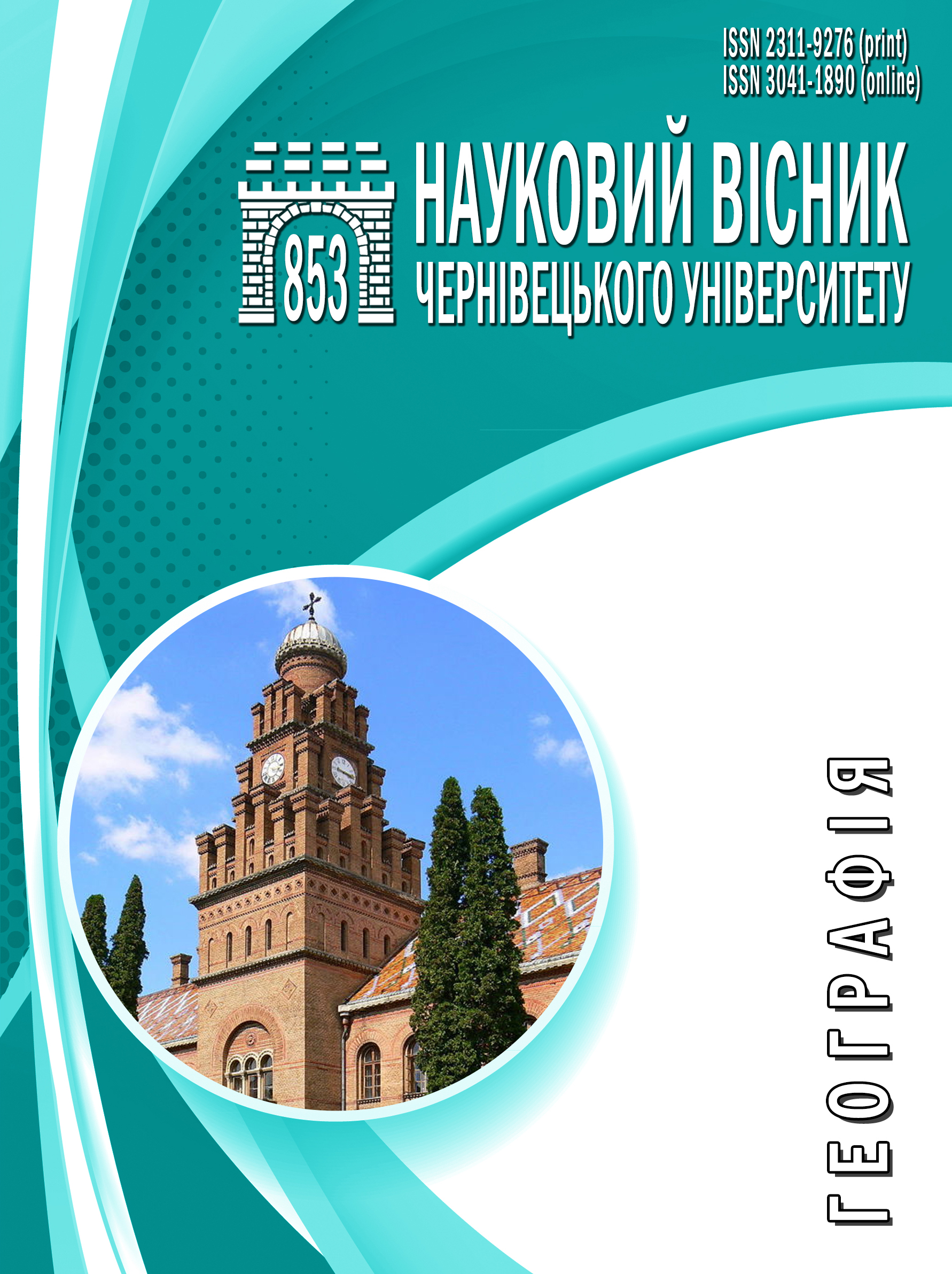Global demographic trends
DOI:
https://doi.org/10.31861/geo.2025.853.121-130Keywords:
demographic asymmetry,, depopulation,, demographic aging,, migration,, macropolization,, ethnic structureAbstract
Abstract: demographic asymmetry, depopulation, demographic aging, migration, macropolization, ethnic structure.
Abstract: The article argues the need to analyze global demographic trends to clarify their impact on national and regional trends in socio-economic development, the development of domestic policy in various areas, and the formation of the state's foreign policy strategy. The population dynamics at the global level are analyzed, and trends in the strengthening of the world demographic asymmetry between developed and developing countries are shown. Uneven population growth results from unequal trends in the decline in birth rate and age-related mortality transformation, and therefore different types of reproduction, which are characteristic of various phases of the second demographic transition. Regional differences in demographic aging trends are shown. The factors and trends of macropolization processes in the world and regions are revealed. Demographic asymmetry and age transformation, along with economic disparities and security challenges, determine the volume and direction of migration processes in the world. Europe has become the largest immigration region in the world, which affects the ethnostructural dynamics in the countries-recipients of migrants. Three groups of European states are distinguished by the reduction in the share of the state-forming ethnic group in the total population for 1987-2019, the share of immigrants at the current stage, and the countries of origin of the largest immigration cohorts. The peculiarities of the impact of global demographic trends on Ukraine in the conditions of war and the post-war period are revealed. The main demographic challenges that will arise after the war are identified. The basic principles of the policy of controlled immigration, which must be introduced in Ukraine, are outlined
References
1. Гудзеляк, І. І. (2021). Вплив міграції на етнічний склад населення Європи. У Суспільна географія і картографія: наукова спадщина та сучасні українознавчі студії: матеріали Всеукраїнського наукового онлайн-семінару з участю закордонних учених, присвяченого 120-літтю від народження професора Володимира Кубійовича (1900‒1985) (с. 184–188). Львів: Простір-М. [Hudzeliak, I. I. (2021). Vplyv mihratsii na etnichnyi sklad naselennia Yevropy. U Suspilna heohrafiia i kartohrafiia: naukova spadshchyna ta suchasni ukrainskoznavchi studii: materialy Vseukrainskoho naukovoho onlain-seminaru z uchastiu zakordonnykh uchenykh, prysviachenoho 120-littiu vid narodzhennia profesora Volodymyra Kubiievycha (1900‒1985) (pp. 184–188). Lviv: Prostir-M.]
2. Гудзеляк, І. І., & Стефаник, У. С. (2014). Старіння населення України. Часопис соціально-економічної географії, 16(1), 89–94. Харків: Харківський національний університет імені В. Н. Каразіна. [Hudzeliak, I. I., & Stefanyk, U. S. (2014). Starinnia naselennia Ukrainy. Chasopys sotsialno-ekonomichnoi heohrafii, 16(1), 89–94. Kharkiv: Kharkivskyi natsionalnyi universytet imeni V. N. Karazina.]
3. Гудзеляк, І. І. (2017). Макрополізація в сучасному світі: глобальні тенденції та регіональні відмінності. Історія української географії. Всеукраїнський науково-теоретичний часопис, 36, 83–88. Тернопіль. [Hudzeliak, I. I. (2017). Makropolizatsiia v suchasnomu sviti: hlobalni tendentsii ta rehionalni vidminnosti. Istoriia ukrainskoi heohrafii. Vseukrainskyi naukovo-teoretychnyi chasopys, 36, 83–88. Ternopil.]
4. Макарова, О., Хмелевська, О., & Герасименко, І. (2024). Оцінювання актуальності та впливу глобальних викликів для національної політики. Демографія та соціальна економіка, 56(2), 62–80. [Makarova, O., Khmelevska, O., & Herasymenko, I. (2024). Otsiniuvannia aktualnosti ta vplyvu hlobalnykh vyklykiv dlia natsionalnoi polityky. Demohrafiia ta sotsialna ekonomika, 56(2), 62–80.] https://doi.org/10.15407/dse2024.02.062
5. Adam, R. G. (2023). Looming demographic shifts in the 21st century. GIS Reports Online. https://www.gisreportsonline.com/r/demographic-changes/
6. Bongaarts, J. (2017). Africa’s unique fertility transition. Population and Development Review, 43(S1), 39–58. https://doi.org/10.1111/j.1728-4457.2016.00164.x
7. Coleman, D. (2006). Immigration and ethnic change in low-fertility countries: A third demographic transition. Population and Development Review, 32(3), 401–446. https://doi.org/10.1111/j.1728-4457.2006.00164.x
8. Dramani, L., Patierno, K., Akpo, K. E., Ndoye, E. M. Y., & Kama, M. C. N. (2022). Eight demographic trends we’re watching as the world population passes 8 billion. https://www.prb.org/articles/eight-demographic-trends-were-watching-as-the-world-population-passes-8-billion/
9. Goldscheider, F., Bernhardt, E., & Lappegård, T. (2015). The gender revolution: A framework for understanding changing family and demographic behavior. Population and Development Review, 41, 207–239. https://doi.org/10.1111/j.1728-4457.2015.00045.x
10. Guzman, J. M. (2024). Past and future demographic trends: Fears, facts and policy implications. Commission on Population and Development. https://www.un.org/development/desa/pd/sites/www.un.org.development.desa.pd/files/undesa_pd_2024_cpd57_guzman_keynote.pdf
11. Hirschman, C. (1994). Why fertility changes. Annual Review of Sociology, 20(1), 203–233. https://doi.org/10.1146/annurev.so.20.080194.001223
12. Kebede, E., Striessnig, E., & Goujon, A. (2021). The relative importance of women’s education on fertility desires in sub-Saharan Africa: A multilevel analysis. Population Studies, 76(1), 137–156. https://doi.org/10.1080/00324728.2021.1892170
13. Reher, D. S. (2015). Baby booms, busts, and population ageing in the developed world. Population Studies, 69 (1), 57–68. https://doi.org/10.1080/00324728.2014.963421
14. Robinson, W. (2024). Global population trends: The prospects for stabilization. Resources. https://www.resources.org/archives/global-population-trends-the-prospects-for-stabilization/
15. Van de Kaa, D. J. (2001). Postmodern fertility preferences: From changing value orientation to new behavior. Population and Development Review, 27, 290–331.
16. Van Der Gaag, N., & De Beer, J. (2015). From demographic dividend to demographic burden: The impact of population ageing on economic growth in Europe. Tijdschrift Voor Economische En Sociale Geografie, 106(1), 94–109. https://doi.org/10.1111/tesg.12084
17. Van Nimwegen, N. (2013). Population change in Europe: Turning challenges into opportunities. Genus, 69(1), 103–125. https://doi.org/10.4402/genus.v69i1.467
18. Eurostat. (n.d.). Джерело
19. Migration Data Portal. (n.d.). Джерело
20. Ukraine Refugee Situation. (n.d.). Джерело
21. United Nations Data: A world of information. (n.d.). Джерело
22. World Population Prospects: The 2024 Revision. (2024). United Nations Department of Economic and Social Affairs, Population Division. Джерело
23. World Population Data Sheet 2024. (2024). Population Reference Bureau. Джерело
24. World Migration Report 2022. (2022). International Organization for Migration (IOM). Джерело
25. World Statistics Pocketbook, 2024 Edition. (2024). United Nations Department of Economic and Social Affairs Джерело
26.World Urbanization Prospects. (2018). United Nations Department of Economic and Social Affairs, Population Division. Retrieved from Джерело
27. Global Trends 2040: A more contested world. (2021). National Intelligence Council. Джерело


